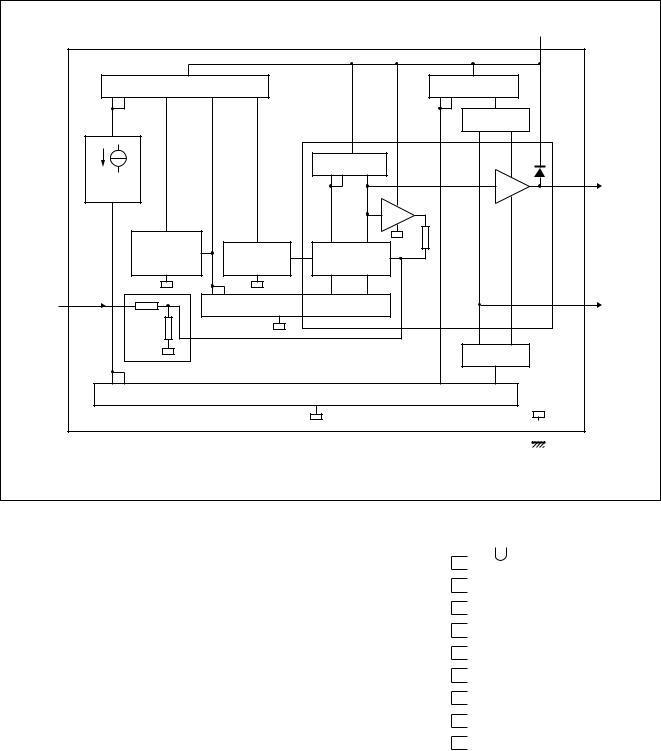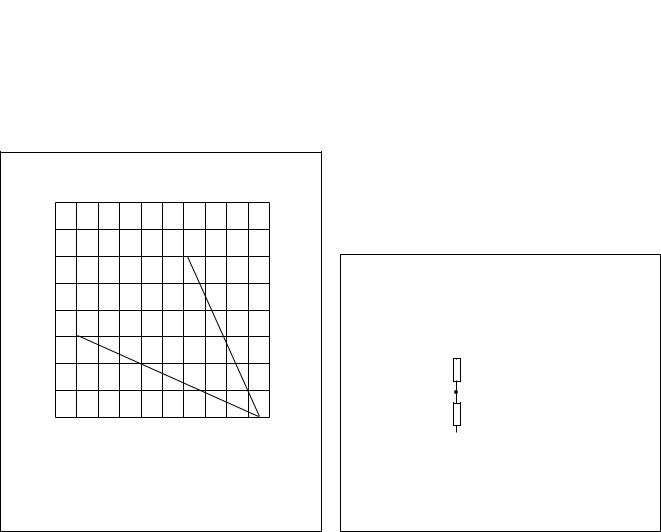Philips TDA6107JF User Manual

INTEGRATED CIRCUITS
DATA SHEET
TDA6107JF
Triple video output amplifier
Product specification |
|
2002 Oct 18 |
|||||
|
|
|
|
|
|
|
|
|
|
|
|
|
|
|
|
|
|
|
|
|
|
|
|

Philips Semiconductors |
Product specification |
|
|
Triple video output amplifier |
TDA6107JF |
|
|
|
|
FEATURES
∙Typical bandwidth of 5.5 MHz for an output signal of 60 V (p-p)
∙High slew rate of 900 V/μs
∙No external components required
∙Very simple application
∙Single supply voltage of 200 V
∙Internal reference voltage of 2.5 V
∙Fixed gain of 50
∙Black-Current Stabilization (BCS) circuit with voltage
window from 1.8 to 6 V and current window from −100 μA to 10 mA
∙Thermal protection
∙Internal protection against positive flashover discharges appearing on the CRT.
ORDERING INFORMATION
GENERAL DESCRIPTION
The TDA6107JF includes three video output amplifiers and is intended to drive the three cathodes of a colour CRT directly. The device is contained in a plastic DIL-bent-SIL 9-pin medium power (DBS9MPF) package, and uses high-voltage DMOS technology.
To obtain maximum performance, the amplifier should be used with black-current control.
TYPE |
|
PACKAGE |
|
|
|
|
|
NUMBER |
NAME |
DESCRIPTION |
VERSION |
|
|||
|
|
|
|
TDA6107JF |
DBS9MPF |
plastic DIL-bent-SIL medium power package with fin; 9 leads |
SOT111-1 |
|
|
|
|
2002 Oct 18 |
2 |

Philips Semiconductors |
Product specification |
|
|
Triple video output amplifier |
TDA6107JF |
|
|
BLOCK DIAGRAM
VDD
|
|
|
|
|
6 |
|
|
MIRROR 1 |
|
|
MIRROR 5 |
|
|
|
|
TDA6107JF |
CASCODE 1 |
|
|
|
|
|
|
|
|
|
|
|
|
|
MIRROR 4 |
3× |
|
|
|
|
|
|
|
Voc(3), |
|
|
CURRENT |
|
|
1× |
9, 8, 7 |
|
|
|
|
Voc(2), |
|||
|
SOURCE |
|
|
|
||
|
|
|
|
|
Voc(1) |
|
|
|
|
|
1× |
|
|
|
|
|
|
|
|
|
|
THERMAL |
|
|
Rf |
|
|
|
PROTECTION |
VIP |
DIFFERENTIAL |
|
|
|
|
CIRCUIT |
REFERENCE |
STAGE |
|
|
|
Vi(1), |
1, 2, 3 |
|
|
|
5 |
|
Vi(2), |
MIRROR 3 |
|
|
I |
||
|
|
|
|
|||
Vi(3) |
Ri |
|
|
|
|
o(m) |
|
|
|
|
|
||
|
Ra |
|
|
|
|
|
|
3× |
|
|
CASCODE 2 |
|
|
|
|
|
|
|
|
|
MIRROR 2
4
MBL525
Fig.1 Block diagram (one amplifier shown).
PINNING |
|
|
|
|
|
|
|
|
|
|
|
|
|
|
|
SYMBOL |
PIN |
DESCRIPTION |
|
handbook, halfpage |
|
|
|
|
|
|
|
||||
|
|
|
|
Vi(1) |
1 |
|
|
Vi(1) |
1 |
inverting input 1 |
|
|
|||
|
Vi(2) |
2 |
|
|
|||
Vi(2) |
2 |
inverting input 2 |
|
|
|
||
|
Vi(3) |
3 |
|
|
|||
Vi(3) |
3 |
inverting input 3 |
|
|
|
||
|
|
|
|
|
|||
GND |
4 |
ground (fin) |
|
GND |
4 |
|
|
|
|
|
|
Iom |
|
|
|
I |
5 |
black-current measurement output |
|
5 |
TDA6107JF |
|
|
om |
|
|
|
|
|
|
|
VDD |
6 |
supply voltage |
|
VDD |
6 |
|
|
Voc(3) |
7 |
cathode output 3 |
|
Voc(3) |
7 |
|
|
Voc(2) |
8 |
cathode output 2 |
|
Voc(2) |
8 |
|
|
Voc(1) |
9 |
cathode output 1 |
|
|
|
||
|
Voc(1) |
9 |
|
|
|||
|
|
|
|
|
|
||
|
|
|
|
|
|
MBL524 |
|
|
|
|
|
Fig.2 |
Pin configuration. |
||
|
|
|
|
|
|
|
|
2002 Oct 18 |
3 |

Philips Semiconductors |
Product specification |
|
|
Triple video output amplifier |
TDA6107JF |
|
|
LIMITING VALUES
In accordance with the Absolute Maximum Rating System (IEC 60134); voltages measured with respect to pin 4 (ground); currents as specified in Fig.1; unless otherwise specified.
SYMBOL |
PARAMETER |
MIN. |
MAX. |
UNIT |
|
|
|
|
|
VDD |
supply voltage |
0 |
250 |
V |
Vi |
input voltage at pins 1 to 3 |
0 |
12 |
V |
Vo(m) |
measurement output voltage |
0 |
6 |
V |
Voc |
cathode output voltage |
0 |
VDD |
V |
Iocsm(L) |
LOW non-repetitive peak cathode output current at a flashover |
0 |
3 |
A |
|
discharge of 100 μC |
|
|
|
|
|
|
|
|
Iocsm(H) |
HIGH non-repetitive peak cathode output current at a flashover |
0 |
6 |
A |
|
discharge of 100 nC |
|
|
|
|
|
|
|
|
Tstg |
storage temperature |
−55 |
+150 |
°C |
Tj |
junction temperature |
−20 |
+150 |
°C |
Ves |
electrostatic handling voltage |
|
|
|
|
Human Body Model (HBM) |
− |
3000 |
V |
|
Machine Model (MM) |
− |
300 |
V |
|
|
|
|
|
HANDLING
Inputs and outputs are protected against electrostatic discharge in normal handling. However, to be totally safe, it is desirable to take normal precautions appropriate to handling MOS devices (see “Handling MOS Devices”).
QUALITY SPECIFICATION
Quality specification “SNW-FQ-611 part D” is applicable and can be found in the “Quality reference Handbook”. The handbook can be ordered using the code 9397 750 00192.
2002 Oct 18 |
4 |

Philips Semiconductors |
|
Product specification |
||
|
|
|
|
|
Triple video output amplifier |
|
TDA6107JF |
||
|
|
|
|
|
THERMAL CHARACTERISTICS |
|
|
|
|
|
|
|
|
|
SYMBOL |
PARAMETER |
CONDITIONS |
VALUE |
UNIT |
|
|
|
|
|
Rth(j-a) |
thermal resistance from junction to ambient |
|
56 |
K/W |
Rth(j-fin) |
thermal resistance from junction to fin |
note 1 |
11 |
K/W |
Rth(h-a) |
thermal resistance from heatsink to ambient |
|
18 |
K/W |
Note
1. An external heatsink is necessary.
8 |
|
|
|
|
MBH989 |
|
|
|
|
|
|
handbook, halfpage |
|
|
|
|
|
Ptot |
|
|
|
|
|
(W) |
|
|
|
|
|
6 |
|
(1) |
|
|
|
|
|
|
|
|
|
4 |
|
|
|
|
|
|
|
(2) |
|
|
|
2 |
|
|
|
|
|
0 |
|
|
|
|
|
−40 |
0 |
40 |
80 |
120 |
160 |
|
|
|
|
Tamb (°C) |
|
(1)Infinite heatsink.
(2)No heatsink.
Thermal protection
The internal thermal protection circuit gives a decrease of the slew rate at high temperatures: 10% decrease at 130 °C and 30% decrease at 145 °C (typical values on the spot of the thermal protection circuit).
handbook, halfpage |
outputs |
|
5 K/W
thermal protection circuit
6 K/W
fin MGK279
Fig.3 Power derating curves. |
Fig.4 Equivalent thermal resistance network. |
2002 Oct 18 |
5 |

Philips Semiconductors |
Product specification |
|
|
Triple video output amplifier |
TDA6107JF |
|
|
CHARACTERISTICS
Operating range: Tj = -20 to +150 °C; VDD = 180 to 210 V. Test conditions: Tamb = 25 °C; VDD = 200 V;
Vo(c1) = Vo(c2) = Vo(c3) = 1¤2VDD; CL = 10 pF (CL consists of parasitic and cathode capacitance); Rth(h-a) = 18 K/W (measured in test circuit of Fig.8); unless otherwise specified.
SYMBOL |
PARAMETER |
CONDITIONS |
MIN. |
TYP. |
MAX. |
UNIT |
|
|
|
|
|
|
|
Iq |
quiescent supply current |
|
5.6 |
6.6 |
7.6 |
mA |
Vref(int) |
internal reference voltage |
|
- |
2.5 |
- |
V |
|
(input stage) |
|
|
|
|
|
|
|
|
|
|
|
|
Ri |
input resistance |
|
- |
3.6 |
- |
kW |
G |
gain of amplifier |
|
47.5 |
51.0 |
55.0 |
|
|
|
|
|
|
|
|
DG |
gain difference |
|
-2.5 |
0 |
+2.5 |
|
|
|
|
|
|
|
|
VO(oc) |
nominal output voltage at |
Ii = 0 mA |
116 |
129 |
142 |
V |
|
pins 7, 8 and 9 (DC value) |
|
|
|
|
|
|
|
|
|
|
|
|
DVO(oc)(offset) |
differential nominal output |
Ii = 0 mA |
- |
0 |
5 |
V |
|
offset voltage between |
|
|
|
|
|
|
pins 7 and 8, 8 and 9 and |
|
|
|
|
|
|
9 and 7 (DC value) |
|
|
|
|
|
|
|
|
|
|
|
|
DVo(c)(T) |
output voltage temperature |
|
- |
10 |
- |
mV/K |
|
drift at pins 7, 8 and 9 |
|
|
|
|
|
|
|
|
|
|
|
|
DVo(c)(T)(offset) |
differential output offset |
|
- |
0 |
- |
mV/K |
|
voltage temperature drift |
|
|
|
|
|
|
between pins 7 and 8, |
|
|
|
|
|
|
8 and 9 and 7 and 9 |
|
|
|
|
|
|
|
|
|
|
|
|
Io(m)(offset) |
offset current of measurement |
Io(c) = 0 mA; |
-50 |
- |
+50 |
mA |
|
output (for three channels) |
1.5 V < Vi < 5.5 V; |
|
|
|
|
|
|
1.8 V < Vo(m) < 6 V |
|
|
|
|
DIo(m)/DIo(c) |
linearity of current transfer |
-100 mA < Io(c) < 100 mA; |
-0.9 |
-1.0 |
-1.1 |
|
|
(for three channels) |
1.5 V < Vi < 5.5 V; |
|
|
|
|
|
|
1.8 V < Vo(m) < 6 V |
|
|
|
|
|
|
-100 mA £ Io(c) < 10 mA; |
-0.9 |
-1.0 |
-1.1 |
|
|
|
1.5 V < Vi < 5.5 V; |
|
|
|
|
|
|
1.8 V < Vo(m) < 4 V |
|
|
|
|
Io(c)(max) |
maximum peak output current |
50 V < Vo(c) < VDD - 50 V |
- |
20 |
- |
mA |
|
(pins 7, 8 and 9) |
|
|
|
|
|
|
|
|
|
|
|
|
Vo(c)(min) |
minimum output voltage |
Vi = 7.0 V; at Io(c) = 0 mA; |
- |
- |
10 |
V |
|
(pins 7, 8 and 9) |
note 1 |
|
|
|
|
|
|
|
|
|
|
|
Vo(c)(max) |
maximum output voltage |
Vi = 1.0 V; at Io(c) = 0 mA; |
VDD - 15 |
- |
- |
V |
|
(pins 7, 8 and 9) |
note 1 |
|
|
|
|
|
|
|
|
|
|
|
BS |
small signal bandwidth |
Vo(c) = 60 V (p-p) |
- |
5.5 |
- |
MHz |
|
(pins 7, 8 and 9) |
|
|
|
|
|
|
|
|
|
|
|
|
BL |
large signal bandwidth |
Vo(c) = 100 V (p-p) |
- |
4.5 |
- |
MHz |
|
(pins 7, 8 and 9) |
|
|
|
|
|
|
|
|
|
|
|
|
tPco |
cathode output propagation |
Vo(c) = 100 V (p-p) square |
- |
60 |
- |
ns |
|
time 50% input to 50% output |
wave; f <1 MHz; |
|
|
|
|
|
(pins 7, 8 and 9) |
tr = tf = 40 ns |
|
|
|
|
|
|
(pins 1, 2 and 3); |
|
|
|
|
|
|
see Figs 6 and 7 |
|
|
|
|
|
|
|
|
|
|
|
2002 Oct 18 |
6 |
